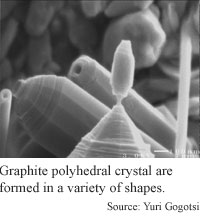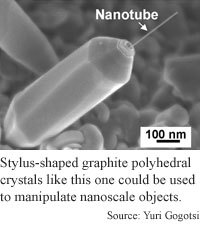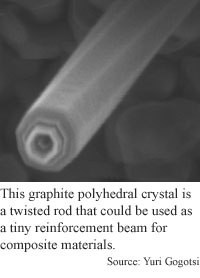
Nanotubes gain larger kin
By Kimberly Patch, Technology Research NewsResearchers have discovered giant nanotubes in the pores of glassy carbon, an industrial material. These graphite polyhedral crystals range up to several orders of magnitude larger than their nanometer-wide cousins, and come in a wide variety of shapes.
The discovery gives scientists a host of strong, perfectly shaped tiny parts that can be used for micro and nanoscale machines.
Graphite polyhedrals, like nanotubes, are made of sheets of graphite rolled into shapes, but range in size from a few nanometers to 1000 nanometers thick and up to several thousand nanometers long. The structures are like nanotubes, "but instead of 10 layers of carbon they have 1000 or 1500 layers of carbon. So they cannot be called nano anymore. That's why we call them giant nanotubes," said Yuri Gogotsi, a professor of materials engineering at Drexel University.
They exist in many shapes including needles, giant nanotubes, rings, cones and double-tipped pyramids. Some combine several shapes into more complicated structures. One example is a giant nanotube that sports holes, a top dome, a stylus protruding from the inside, and several rings of different thickness around the outside, Gogotsi said.
The graphite polyhedrals can stretch into more varied shapes than nanotubes because they have more layers, Gogotsi said. "It's like when you take a fabric and try to roll it to make a cylinder. You can change the orientation depending on how you pull it." In a similar way, the graphite polyhedrals will form different shapes if their graphite layers are slightly askew.
Because nanotubes are very thin, differences in the orientation of the graphite sheets don't make much of a difference. It's only when many more layers are added that that the differences translate to substantial changes in the shape of the structure, Gogotsi said.
The researchers also found hollow graphite crystals with more complicated structures. "These are shell type crystals with similar shapes, sometimes double tips... that have very complex symmetry and can't be described simply," said Gogotsi.
The graphite polyhedral discovery was accidental, said Gogotsi. "We were studying the stability of [glassy carbon] in supercritical water. But before doing the experiments, my students did a careful electromicroscopy study of the sample. We found something beautiful -- very unusual -- all the pores are filled with [these] crystals," he said. The course of their research quickly changed. "We put major effort [into studying] the structure to understand how they are built," Gogotsi said
Like nanotubes, graphite polyhedrals are probably common, but easy to overlook. When glassy carbon was developed for commercial purposes, it was not possible to see well into the pores of the material. "They were just not able to resolve the crystals clearly and they didn't pay any attention to them," Gogotsi said. "This is similar to nanotubes, which were discovered [less than] 10 years ago but they exist in virtually any kind of soot from a flame -- you can find nanotubes in your fireplace," he said.
The larger graphite polyhedrals can be used to bridge the gap from micro to nano scale mechanical structures said Gogotsi. Currently, it's not possible to machine structures small enough to manipulate nanotubes, for example. Researchers working on microelectricalmechanical systems (MEMS) are searching for ways to incorporate the much smaller nanotubes into their devices as bearings, actuators, electrodes and sensors.
Graphite polyhedrals are large enough to manipulate or fix electrodes to, and they can be grown as holders for nanotubes. "We have nanotubes... seated in fairly thick one-micron holders that you can manipulate with existing means," said Gogotsi.
The discovery "is really interesting," said Jie Han, a research scientist at NASA Ames Research Center. "It makes a continum spectrum of carbon materials from carbo fiber and diamond down to [graphite polyhedral structures] and then down to carbon nanotubes and fullerenes," said Han.
The researchers next steps are exploring the size limits of the structures and developing a process to make them in large quantities, said Gogotsi. In theory, they could be grown larger than those found, because those structures were limited by the size of the pores they grew in," Gogotsi said. "There is no physical reason why they should not grow to much larger sizes, it's just a matter of engineering technology," he said.
The structures could be put to practical use within a year, he added.
The researchers also plan to study more carefully the hollow crystals that differ from nanotubes and published a paper on their structure sometime early next year, Gogotsi said.
The study was funded by the University of Illinois, where Gogotsi worked until this August. Continuing funding for the project is from Drexel University.
Gogotsi's colleagues in the project were Joseph A. Libera and Nicolay Kalashnikov from the University of Illinois and Masahiro Yoshimura from the Tokyo Institute of Technology. They published their findings in the October 13, 2000 issue of Science.
Timeline: 1 year
Funding: University
TRN Categories: Semiconductors and Materials; Nanotechnology
Story Type: News
Related Elements: Photo 1, Photo 2; Photo 3; Technical paper, "Graphite Polyhedral Crystals," Science, October 13, 2000
Advertisements:
October 18, 2000
Page One
Nanotubes gain larger kin
Quantum computing without weirdness
Pyramid pixels promise sharp pictures
Molecule movement could make memory
Researchers make cheap telecom laser



News:
Research News Roundup
Research Watch blog
Features:
View from the High Ground Q&A
How It Works
RSS Feeds:
News
Ad links:
Buy an ad link
| Advertisements:
|
 |
Ad links: Clear History
Buy an ad link
|
TRN
Newswire and Headline Feeds for Web sites
|
© Copyright Technology Research News, LLC 2000-2006. All rights reserved.